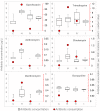Abundance and Antimicrobial Resistance of Three Bacterial Species along a Complete Wastewater Pathway
- PMID: 31484380
- PMCID: PMC6780886
- DOI: 10.3390/microorganisms7090312
Abundance and Antimicrobial Resistance of Three Bacterial Species along a Complete Wastewater Pathway
Abstract
After consumption, antibiotic residues and exposed bacteria end up via the feces in wastewater, and therefore wastewater is believed to play an important role in the spread of antimicrobial resistance (AMR). We investigated the abundance and AMR profiles of three different species over a complete wastewater pathway during a one-year sampling campaign, as well as including antimicrobial consumption and antimicrobial concentrations analysis. A total of 2886 isolates (997 Escherichia coli, 863 Klebsiella spp., and 1026 Aeromonas spp.) were cultured from the 211 samples collected. The bacterial AMR profiles mirrored the antimicrobial consumption in the respective locations, which were highest in the hospital. However, the contribution of hospital wastewater to AMR found in the wastewater treatment plant (WWTP) was below 10% for all antimicrobials tested. We found high concentrations (7-8 logs CFU/L) of the three bacterial species in all wastewaters, and they survived the wastewater treatment (effluent concentrations were around 5 log CFU/L), showing an increase of E. coli in the receiving river after the WWTP discharge. Although the WWTP had no effect on the proportion of AMR, bacterial species and antimicrobial residues were still measured in the effluent, showing the role of wastewater contamination in the environmental surface water.
Keywords: Aeromonas spp.; Escherichia coli; Klebsiella spp.; antimicrobial consumption; antimicrobial residues; antimicrobial resistance; bacterial abundance; clinical wastewater; wastewater pathway; wastewater treatment plant.
Conflict of interest statement
The authors declare no conflict of interest. The funders had no role in the design of the study; in the collection, analyses, or interpretation of data; in the writing of the manuscript, or in the decision to publish the results.
Figures





References
-
- WHO . Antimicrobial Resistance Global Report on Surveillance. World Health Organization; Geneva, Switzerland: 2014.
-
- ECDC . Summary of the Latest Data on Antibiotic Consumption in the European Union. European Centre for Disease Prevention and Control; Solna Municipality, Sweden: 2017.
LinkOut - more resources
Full Text Sources
Molecular Biology Databases
Miscellaneous

